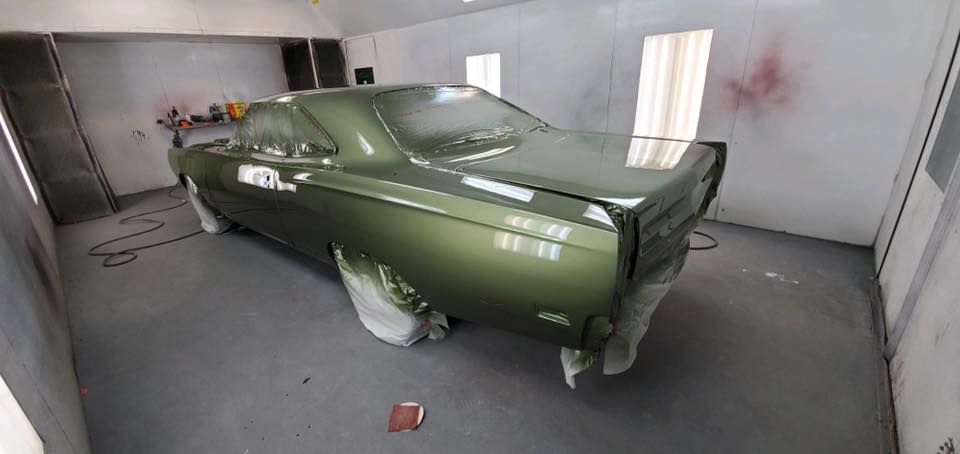

This was an Electra Glide based on the FLT Tour Glide frame, but using the Electra Glide "batwing" fairing instead of the Tour Glide frame-mounted fairing. In order that the FLT frame, which was larger and heavier than the large and heavy FLH frame, would handle acceptably, the front forks were given radical steering geometry which had them mounted behind the steering head, with the frame behind the steering head being recessed to allow adequate steering lock. Sold alongside the existing FLH Electra Glide, the FLT had a larger frame with rubber engine mounts, a five-speed transmission, the 80 cu in (1,300 cc) engine, and a frame-mounted fairing.

The FLT Tour Glide was introduced in 1979 as a 1980 model. The low-compression FL engine was discontinued in 1979, as was the option for hand-shift/foot-clutch transmission controls. By 1981, the 80 cubic inch engine was the standard engine the 74 cu in (1,210 cc) engine being discontinued. However, the FL designation was not changed as a result.

Īn 80 cu in (1,300 cc) engine was made optional on the Electra Glide in 1978. The unit production was in such low volume numbers - only 44 - as to make it one of the rarest of the company's motorcycles. Ī 1977 Harley-Davidson Confederate Edition of the FLH Electra Glide that featured commemorative paint and tank and fender decals was produced.
Florida custom paint fx. plus#
The three-speed plus reverse option was discontinued in 1977. The FL was given a front disc brake in 1972. The FX mated the FL frame with the forks of the XL Sportster, with buckhorn handlebars and a large fibreglass tailpiece completing the Super Glide specification. The FL frame was the basis for the 1971 FX Super Glide. The FLH designation has continued up to the present. Ī more highly tuned engine with high-compression heads, higher-lift cams, and polished ports, was offered with the FLH version of 1955. Īlthough the 1903 founding is now the basis for "Anniversary Models", Harley-Davidson's 50th Golden Anniversary was celebrated in 1954 with special paints and badges on the front fender. 1952 was also the last year of the 61 cu in (1,000 cc) EL, making the FL the last remaining large-frame model. The original format continued to be offered as an option until 1978. In 1952, the Hydra-Glide's transmission standard hand-shift/foot-clutch was supplemented by the optional foot-shift/hand-clutch. In addition, the Glide ending would be used on other models, based on both and FL and FX formats.
Florida custom paint fx. series#
This name would change twice in the history of the basic large-framed E and F series models, each time signaling an improvement in the bike's technology.

This was Harley-Davidson's first departure from its policy of using alphabetic lettering to identify its models. Harley-Davidson's marketing department promoted the new suspension systems by renaming the big twin models "Hydra Glide" for the 1950 model year. ĭuring their debut model year of 1949, Harley-Davidson referred to their new suspension systems as the "hydraulic front ends". Harley-Davidson offered the spring suspension units on these models and recommended their use on sidecar combinations, because the hydraulic forks did not have enough trail to allow the combination to be stable enough for safe operation. These forks were standard on all big twin models for 1949, including the E, EL, F, and FL. In 1949, a year after receiving the "Panhead" engine, the FL was given a new front suspension featuring hydraulically damped telescopic forks, replacing the leading link spring suspension of the time. The U and UL flathead twins were discontinued in 1948, leaving the OHV EL and FL models as Harley-Davidson's large-frame motorcycles. These engines had several improvements over the earlier "Knuckleheads", including self-adjusting hydraulic lifters and aluminum cylinder heads to reduce weight and improve cooling. The FL continued relatively unchanged until 1948, when it and the EL were given redesigned " Panhead" engines of the same capacities as before. The FL replaced the UH and ULH, which used the same frame with 80 cu in (1,300 cc) flathead engines. The FL shared its frame with the EL and with the U and UL, which used a 74 cubic inch flathead engine. It used a 74 cu in (1,210 cc) version of the " Knucklehead" OHV engine that powered the EL in 61 cu in (1,000 cc) form. The FL was introduced to the Harley-Davidson model line in 1941.


 0 kommentar(er)
0 kommentar(er)
